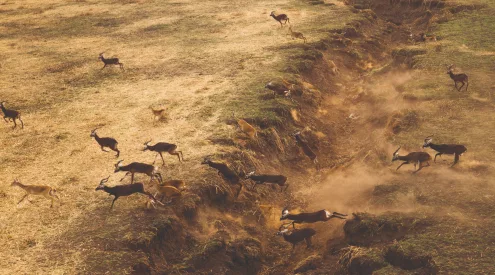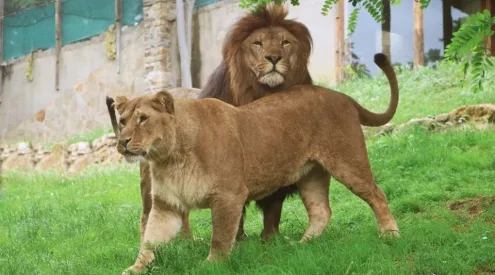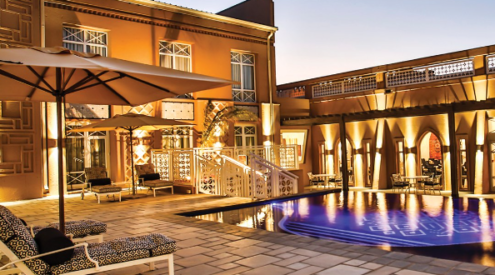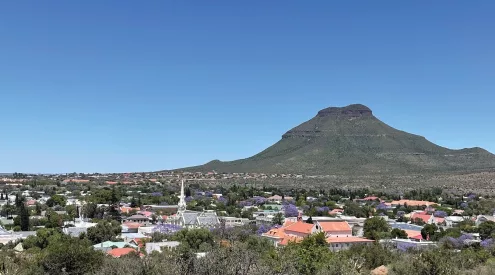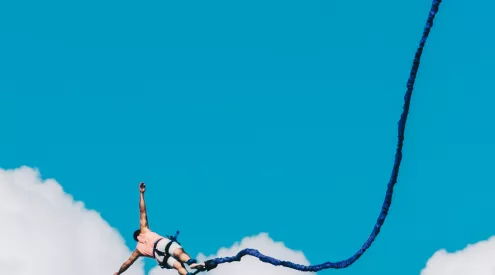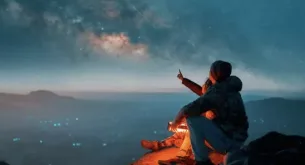Mistakes and miscommunication. Bungles and blunders. These aren’t ideal words to use about a military battle. Yet they describe what happened at Spion Kop to a T, as we discovered when we toured this KwaZulu-Natal battlefield near Winterton with Alastair Heron of Spion Kop Lodge.

Looking out towards Spion Kop from Mount Alice, Alastair Heron (second from left) gives the first hint of serious bungling. Photo by Roxanne Reid.
On 24 January 1900, Spion Kop was the site of one of the most futile battles of the Anglo-Boer War of 1899-1902. The British under General Buller had already tried at the Battle of Colenso to relieve the siege of Ladysmith. ‘He lost 1000 men and ten artillery pieces to the Boers, so it wasn’t really a very successful day for him,’ said Alastair dryly. Now Buller was trying again to relieve the besieged town.
The Boers, naturally, were trying to stop him.
With us were Brian and Julie Kisch. His great-grandfather David Henry Kisch was a photographer in Ladysmith during the siege, his premises next to the Royal Hotel that still stands on the main road. Many of his photographs are on display in the Ladysmith Siege Museum. Her grandmother’s brother Arthur Brent of the Imperial Light Infantry was killed at the battle of Spion Kop. Having them there made history real, a living connection with a battle over 100 years ago.
From the top of Mount Alice, Buller’s HQ during the battle, we saw that he’d had an excellent view of Spion Kop, Aloe Knoll and Twin Peaks. He should have been well placed to follow what was happening on the battlefield, but the way Alastair tells it there were some communication mess-ups among the British. Sometimes people didn’t know who was really in command on the hill. At one point Buller put Lieutenant-Colonel Thorneycroft in charge, but the soldier carrying the message didn’t manage to deliver it and it was only later that Thorneycroft realised he’d supposedly been calling the shots.
Picture it: 500 000 British troops, 69 000 Boer volunteers pitted against each other in the war. The British forces were cumbersome and slow-moving; the Boers were fast, used to the conditions of the veld. ‘They’d been shooting since they were yay high to a toadstool, and some were deadly accurate to 1000 yards with an open sight. But they had no military training or knowledge of the standard rule book,’ said Alastair.
So, on that mistake-full day, the British took what they thought was the top of Spion Kop and started digging a trench in the hard, rocky ground. ‘It’s said they used their bayonets to dig,’ said Alastair. But when the mist cleared and the Boers started shelling them, they saw they weren’t actually at the top of the koppie and had to repeat the whole trench-digging exercise higher up before they could start firing back.
A day of horrors
‘Try to imagine what it was like on that day,’ said Alastair. ‘40 degrees, hellishly hot without a breath of wind. Lots of dead soldiers, so the smell must have been overpowering. Millions of flies. And no water.’
Thinking they were getting the worst of the battle but not realising how badly they were pounding the Brits, the Boers retreated. With British soldiers lying dead all around and the Kings Royal Rifles leaving the Twin Peaks, Thorneycroft also decided to retreat. ‘So the whole day of battle was futile and neither side claimed the hill,’ said Alastair, although the Boers did at least prevent the relief of Ladysmith.

Note the difference in the English and Afrikaans information on this grave. The English simply says a sentry was killed; the Afrikaans calls him a ‘freedom fighter’ on sentry duty. Photo by Roxanne Reid
The Boers lost 58 men, many of them put on their horses and sent back to their farms for burial. The number of British soldiers killed varies according to sources, though the official number is 322. ‘But remember,’ said Alastair, ‘the British had lost three major battles during Black Week just before Christmas, so they probably thought the British public couldn’t take the truth and deliberately gave a low estimate.’ During Black Week nearly 3000 men had been killed, wounded or captured, making the British realise for the first time that they weren’t so easily going to win the war.

On a grey day with a howling wind, we saw the long trenches where British soldiers were buried. Photo by Roxanne Reid
The day after the battle of Spion Kop was one of armistice when the Boers helped the Brits bury their dead, widening and deepening the trenches, piling the bodies in and covering them with rocks. You can still see these raised, rock-filled trenches today on the Acre of Massacre at the top of the hill. There are some individual graves and three memorials too – to the Imperial Light Infantry, the British soldiers and the Boer dead.
Julie found her great-uncle Arthur Brent, no 544, on the Imperial Light Infantry memorial and added one small rock onto one of the trenches in his honour. At the Boer memorial, there were places where the same surname was listed for two deaths from a single town; it was hard not to feel the pain of those families, whether two brothers or father and son.
As we stood in a harsh, cold wind, the waste of lives was weighing on us all when Alastair reminded us that three men who later influenced the course of world history were in the area on that day in 1900: Boer general Louis Botha later became president of the Union of South Africa, a young Winston Churchill was there as part of the SA Light Horse, and Mohandas Gandhi later became known for his nonviolent philosophy of passive resistance. Sources differ as to whether Gandhi was there that day as a stretcher bearer. ‘But at Spion Kop Lodge we believe he went to the Spion Kop conflict area as a volunteer,’ said Alastair.
You get to the site via a steep hill that gives sweeping views out over Spion Kop dam and rolling hills. You could visit on your own because there are some posters telling you what happened, and a well-marked trail to the memorials and trenches. But I’d strongly recommend visiting with a guide who knows his stuff and can make history rear up and come to technicolour life.
Spion Kop Lodge
Tel: 036 488 1404, www.spionkop.co.za
Battlefields Route KwaZulu Natal
Tel: 082 690 7812, www.battlefieldsroute.co.za

